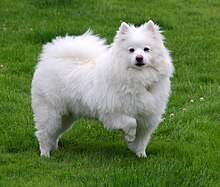American Eskimo Dog

American Eskimo Dog (miniature size)
|
||||||||||||||
| Other names | Eskimo Spitz American Spitz German Spitz |
|||||||||||||
|---|---|---|---|---|---|---|---|---|---|---|---|---|---|---|
| Common nicknames | Eskie | |||||||||||||
| Origin | Germany | |||||||||||||
|
||||||||||||||
|
||||||||||||||
| Domestic dog (Canis lupus familiaris) | ||||||||||||||
| Traits | |||
|---|---|---|---|
| Coat | soft dense |
||
| Color | white | ||
| Classification / standards | |||
|---|---|---|---|
| AKC | Non-sporting | standard | |
| CKC | Group 6, Non-sporting | standard | |
| UKC | Northern Breed | standard | |
The American Eskimo Dog is a breed of companion dog originating in Germany. The American Eskimo is a member of the Spitz family. The breed's progenitors were German Spitz, but due to anti-German prejudice during the First World War, it was renamed "American Eskimo Dog". Although modern American Eskimos have been exported as German Spitz Gross (or Mittel, depending on the dog's height), the breeds have diverged and the standards are significantly different. In addition to serving as a watchdog and companion, the American Eskimo dog also achieved a high degree of popularity in the United States in the 1930s and 1940s as a circus performer.
There are three size varieties of the American Eskimo breed, the toy, miniature and the standard. They share a common resemblance with Japanese Spitz, Danish Spitz, Volpino Italiano, German Spitz and Samoyed dog.
The American Eskimo Dog was originally bred to guard people and property and, therefore, is territorial by nature and a valiant watchdog. It is not considered an aggressive breed but, due to its watchdog history, American Eskimo dogs are generally quite vocal, barking at any stranger who comes in proximity to their owners' territory.
In Northern Europe, smaller Spitz were eventually developed into the various German Spitz breeds. European immigrants brought their Spitz pets with them to the United States, especially New York, in the early 1900s, "all of them descended from the larger German Spitz, the Keeshond, the white Pomeranian, and the Italian Spitz, the Volpino Italiano."
Although white was not always a recognized color in the various German Spitz breeds, it was generally the preferred color in the US. In a display of patriotism in the era around World War I, dog owners began referring to their pets as American Spitz rather than German Spitz.
...
Wikipedia
